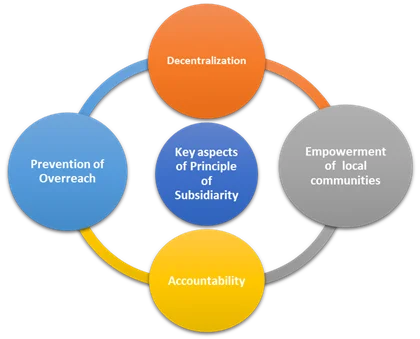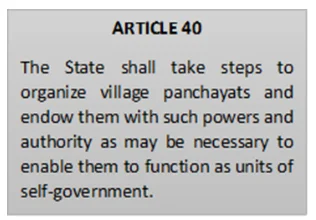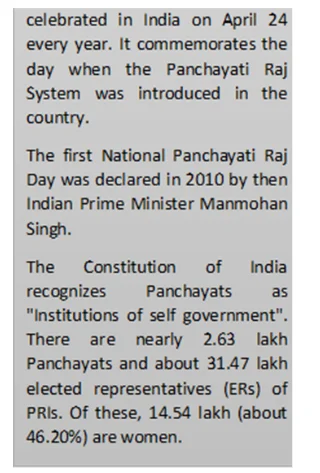Panchayati Raj is a vital local self-governance system in rural India, aimed at promoting grassroots democracy and empowering communities. Established through the 73rd Constitutional Amendment in 1992, it features a three-tier structure that facilitates local governance at the village, block, and district levels. This system is designed to enable effective decision-making and local development, following the principle of subsidiarity, which advocates for decentralization. Various committees have significantly shaped its evolution and structure.
Panchayati Raj in India: Historical Evolution and Key Committees for Decentralized Governance #
Historical Roots and Constitutional Significance #
- Introduction to Panchayati Raj: Panchayati-Raj is a local self-governance system in rural India, with the term “Panchayati-raj” signifying “rule by five.”
- Historical Roots: It is rooted in the Ancient political history of the Indian subcontinent, where five elder villagers made decisions concerning the village’s upkeep and growth.
- Constitutional Framework: Post-independence, the Panchayati Raj framework was given constitutional status through the 73rd constitutional amendment in 1992, featuring a three-tier administrative structure aimed at rural development.
- Objectives of Panchayati Raj: Its objective is to foster local self-governance at the district, zonal, and village levels, while also promoting grassroots democracy, empowering rural communities, and facilitating local development and administration.
- Empowering the people present at the lowest level with the devolution of powers is based on the principle of Subsidiarity.

Enroll now for UPSC Online Course
- Principle of Subsidiarity
- The principle of subsidiarity is a political concept that emphasizes decentralization and local decision-making in governance.
- It suggests that matters should be handled by the smallest, lowest, or least centralized competent authority rather than a higher or more central authority.
- The devolution of powers to PRIs and Municipalities by State governments is also based on this principle.
Panchayati Raj Evolution #
The history of Panchayat Raj in Modern India can be categorized into distinct periods when viewed analytically:
- British Period: Under British rule, village panchayats lost their autonomy and grew weaker.
- Emergence of Local Institutions: However, Representative local institutions began to develop in 1870, largely due to Mayo’s resolution in 1870, which expanded their powers and responsibilities.
- Royal Commission on Decentralization: Local self-governance gained momentum with the appointment of the Royal Commission on Decentralization in 1907, chaired by C.E.H. Hobhouse.
- The commission recognized the importance of village panchayats.

-
- Montagu-Chelmsford Reforms: Later on, the Montagu Chelmsford reforms of 1919 transferred local government to the provinces.
- Post-Independence Period: After the Indian Constitution came into effect, Article 40 mentioned Panchayats, and granted State legislatures the authority to legislate on matters related to local self-government.
- Opposition to Panchayat Inclusion: There was opposition to the inclusion of panchayats in the Constitution, primarily from B.R. Ambedkar, who saw them as a caste-based institution and a tool for exploiting marginalized classes.
- Constitutional Recognition: Eventually, panchayats found their place in the Constitution under Article 40 of the Directive Principles of State Policy.

- Post-Independence Development Initiatives:
- Post-Independence Initiatives: Following India’s independence, the Community Development Programme (CDP) in 1952 and the National Extension Service (NES) in 1953 were initiated.
- These programs encountered challenges, such as bureaucracy apathy, political interference, and lack of community participation.
- Balwant Rai Mehta Committee: In January 1957, a committee led by Balwant Rai G Mehta was formed to review and enhance the CDP and NES.
- Rajasthan pioneered Panchayati Raj in 1959 based on this committee’s recommendations, with other States like Andhra Pradesh adopting it later.
- Constitutional Amendment: In 1992, the 73rd Constitutional Amendment Act was enacted, formalizing Panchayati Raj institutions, which came into effect on April 24, 1993, celebrated as National Panchayati Raj Day.
- Post-Independence Initiatives: Following India’s independence, the Community Development Programme (CDP) in 1952 and the National Extension Service (NES) in 1953 were initiated.
Various Committees Related to Panchayati Raj #
| S.No | Name of the Committee | Major recommendations of the Committee |
| 1. | Balwant Rai Mehta Committee, 1957 |
|
| 2. | Ashok Mehta Committee, 1977
|
|
| 3. | G V K Rao Committee, 1985
|
|
| 4. | L M Singhvi Committee, 1986 |
|
| 5. | Thungon Committee, 1988 |
|
| 6. | Gadgil Committee, 1988 |
|
Enroll now for UPSC Online Course
| Must Read | |
| Current Affairs | Editorial Analysis |
| Upsc Notes | Upsc Blogs |
| NCERT Notes | Free Main Answer Writing |
Conclusion #
The journey of Panchayati Raj has been shaped by several influential committees, each contributing valuable recommendations to enhance local governance.
- These committees emphasized the need for a decentralized system with elected representatives and reserved seats for marginalized communities.
- By fostering local participation and empowering rural populations, Panchayati Raj plays a crucial role in India’s development and democracy. Its continued evolution reflects the commitment to effective self-governance and community empowerment in rural areas.
Sign up for the PWOnlyIAS Online Course by Physics Wallah and start your journey to IAS success today!
| Related Articles | |
| Panchayati Raj in India | 73rd CONSTITUTIONAL AMENDMENT ACT, 1992 |
| LOCAL SELF-GOVERNANCE IN INDIA | The Montagu-Chelmsford Reforms |

 GS Foundation
GS Foundation Crash Course
Crash Course Combo
Combo Optional Courses
Optional Courses Degree Program
Degree Program












